【Day26】[演算法]-快速排序法Quick Sort
快速排序法(Quick Sort)又称分割交换排序法,是目前公认效率极佳的演算法,使用了分治法(Divide and Conquer)的概念。原理是先从原始资料列中找一个基准值(Pivot),接着逐一将资料与基准值比较,小於基准值的资料放在左边,大於基准值的资料放在右边,再将两边区块分别再找出基准值,重复前面的步骤,直到排序完为止。
常用的基准值(Pivot)选择方式:
- 选择第1笔或最後1笔的资料
- 随机乱数
- 三数中位数(Median-of-three),第一、中间、最後笔资料,排序之後取中间的值(Musser, 1997)。
例如: 1,5,9,6,3,取出1,9,3,排序後1,3,9,取3为基准点。
平均时间复杂度为: O(n log n)
由於快速排序法有多种实作版本,下面介绍常见的3种实作版本。
递回版本
此版本虽然容易理解,但会影响到空间复杂度,每次都需要申请两个子数列的记忆体空间,递回的深度越多,需要记忆体空间就越大。
操作流程:
- 资料列中找出一个基准值(Pivot)
- 将小於Pivot的资料放在左边,大於Pivot的资料放在右边
- 左右两边资料分别重复1~2步骤,直到剩下1笔资料
- 合并
下面利用50 90 70 20 10 30 40 60 80由小到大排序。
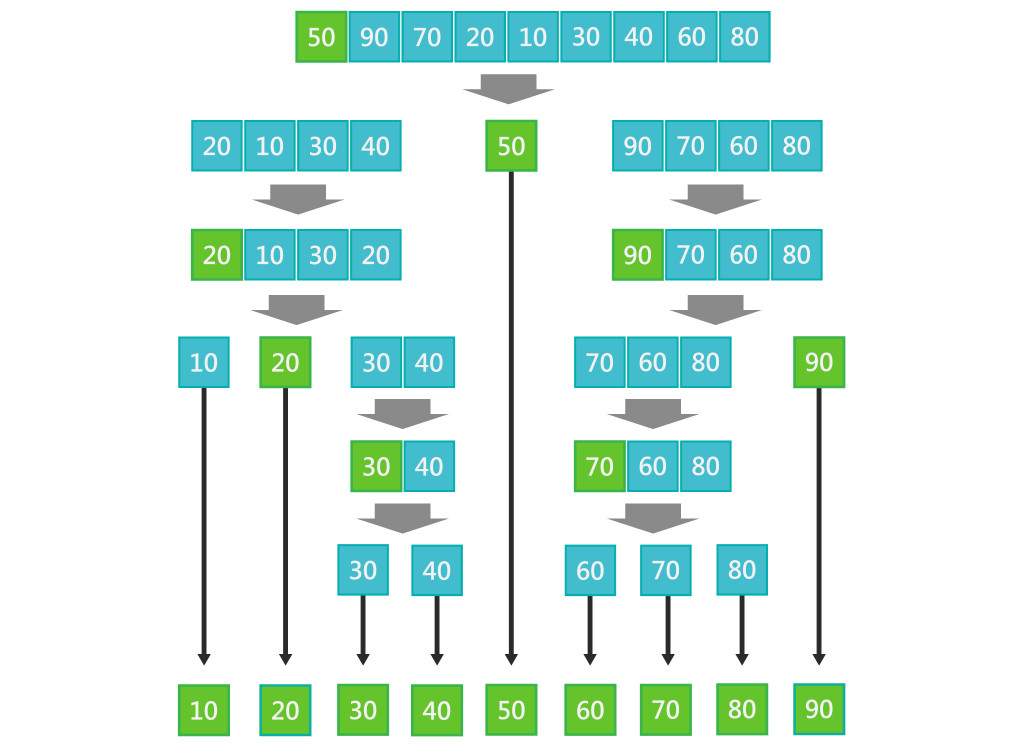
JavaScript
let data = [50,90,70,20,10,30,40,60,80]
function quickSort(arr) {
if (arr.length <= 1) {
return arr;
}
let left = [];
let right = [];
let pivot = arr[0];
for (let i = 1; i < arr.length; i++) {
let num = arr[i];
if (num < pivot) {
left.push(num);
} else {
right.push(num);
}
}
return [...quickSort(left), pivot, ...quickSort(right)];
}
console.log(quickSort(data))//[10, 20, 30, 40, 50, 60, 70, 80, 90]
Python
#Quick Sort
def QuickSort(arr):
n = len(arr)
if n <= 1:
return arr
left = []
right = []
pivot = arr[0]
for i in range(1,n):
if arr[i] < pivot:
left.append(arr[i])
else:
right.append(arr[i])
return QuickSort(left) + [pivot] + QuickSort(right)
data = [50,90,70,20,10,30,40,60,80]
print(QuickSort(data))#[10, 20, 30, 40, 50, 60, 70, 80, 90]
原地交换版本(In-Place)-Lomuto partition scheme
基於Lomuto partition scheme的原理,原始资料列使用一个指标与索引,当索引的资料小於Pivot时,索引的资料与指标位置资料交换。
前面的版本会需要额外的记忆体空间,In-Place版本不需要额外的子数列记忆体空间,因为只会更改原本的数列,切割的同时也就等同合并了,所以只需花费常数O(1)的空间复杂度。实作时会需要用到Partition辅助函式,来直接分割原本的数列。
操作流程:
- 资料列最後一笔设定为基准值(Pivot)
- 设定一个指标指向资料列第一笔,用来记录小於Pivot的资料位置
- 逐一与Pivot比较
- 若当前资料小於Pivot,就将该资料与指标位置的资料做交换,接着指标往下一个位置移动
- 若当前资料大於等於Pivot,则跳过不做任何动作
- 当所有资料比较过後,再将Pivot与指标位置的资料交换
- 左右两边资料列分别重复1~6步骤,直到剩下1笔分割交换完成,不须合并
下面利用90 40 10 60 70 30 80 20 50由小到大排序。
单回合细节图
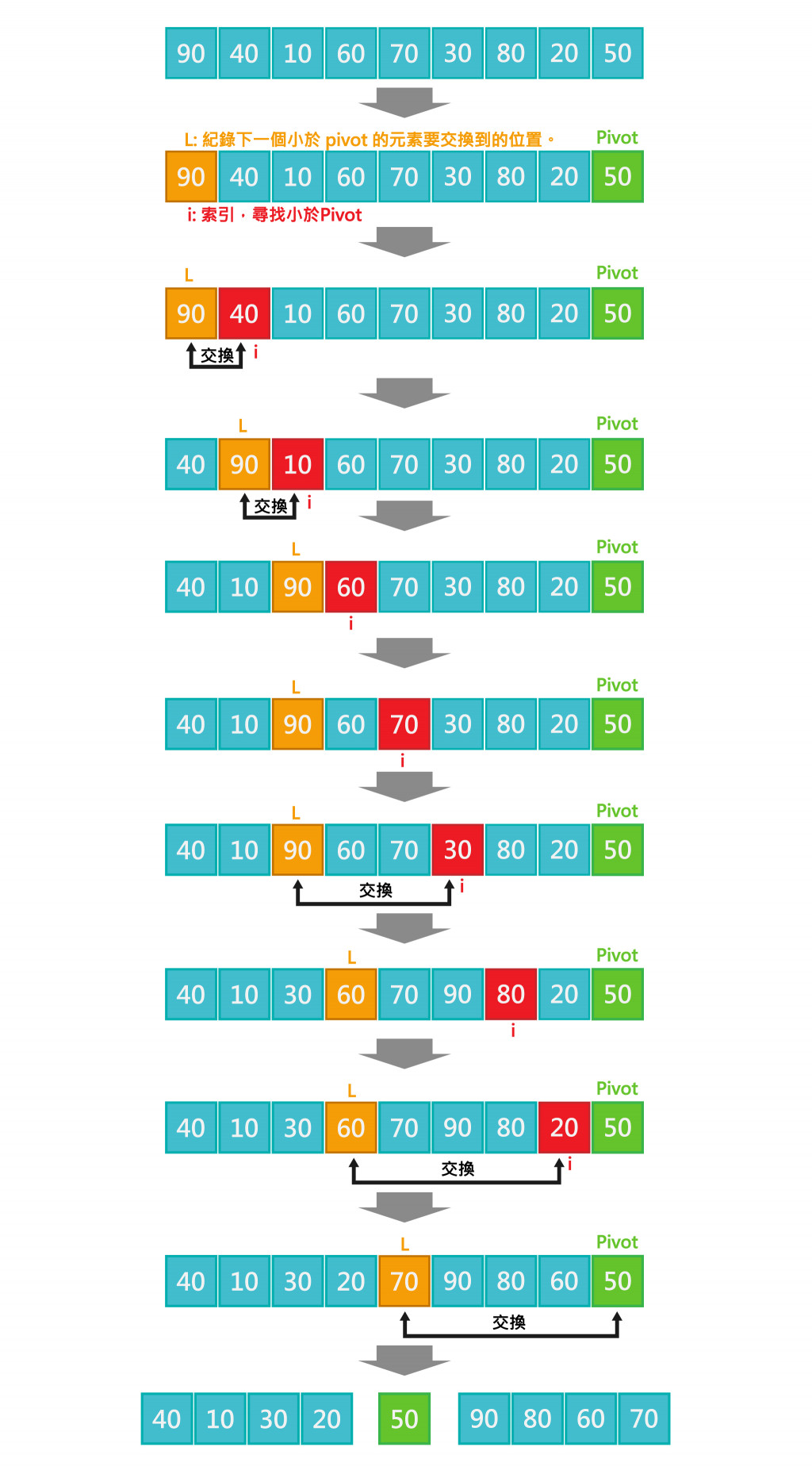
每回合简略图
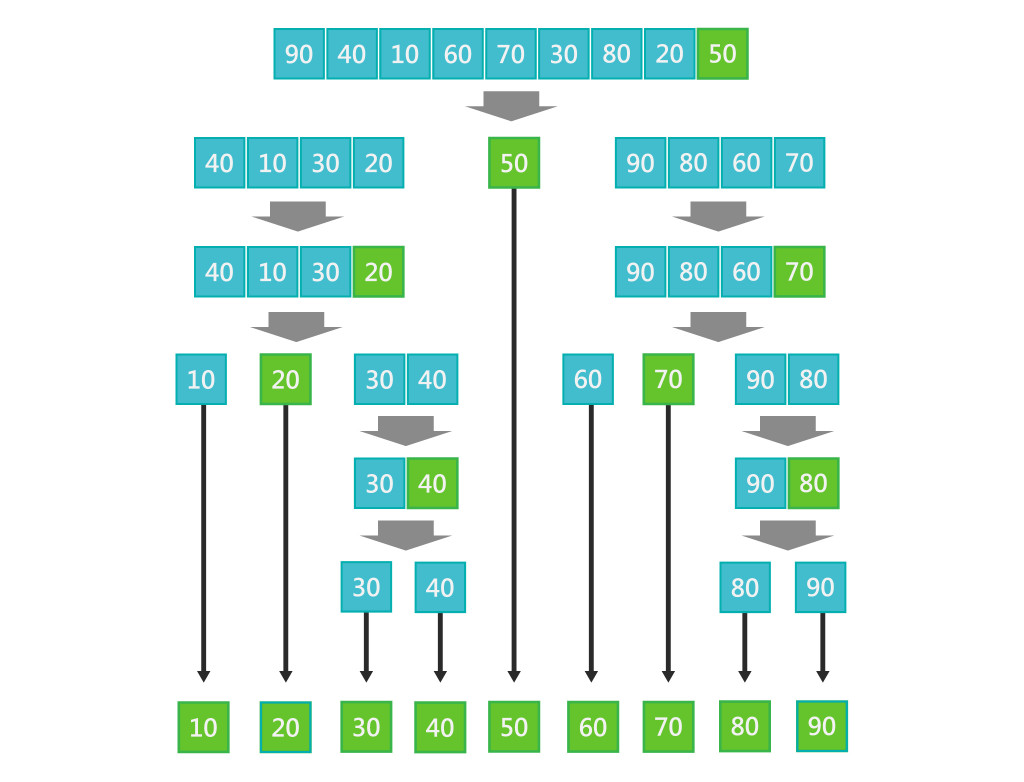
JavaScript
let data = [90, 40, 10, 60, 70, 30, 80, 20, 50];
function quickSort(arr, start, end) {
if (start < end) {
const pivotIndex = partition(arr, start, end);
quickSort(arr, start, pivotIndex - 1);
quickSort(arr, pivotIndex + 1, end);
}
return arr
}
function partition(arr, start, end) {
let pivot = arr[end];
let nextIndex = start;
for (let i = start; i < end; i++) {
if (arr[i] < pivot) {
[arr[nextIndex],arr[i]] = [arr[i],arr[nextIndex]]
nextIndex++;
}
}
[arr[nextIndex],arr[end]] = [arr[end],arr[nextIndex]]
return nextIndex
}
console.log(quickSort(data, 0, data.length - 1)) //[10, 20, 30, 40, 50, 60, 70, 80, 90]
Python
def QuickSort(arr, start, end):
if start < end:
pivotIndex = partition(arr, start, end)
QuickSort(arr, start, pivotIndex - 1)
QuickSort(arr, pivotIndex + 1, end)
return arr
def partition(arr, start, end):
n = len(arr)
pivot = arr[end]
nextIndex = start
for i in range(start,n-1):
if arr[i] < pivot:
arr[nextIndex],arr[i] = arr[i],arr[nextIndex]
nextIndex += 1
arr[nextIndex],arr[end] = arr[end],arr[nextIndex]
return nextIndex
data = [50,90,70,20,10,30,40,60,80]
print(QuickSort(data, 0 , len(data)-1))
#[10, 20, 30, 40, 50, 60, 70, 80, 90]
原地交换版本(In-Place)-Hoare partition scheme
基於Hoare partition scheme的原理,将原始资料列使用两个指标,从资料列的两端开始相互移动,直到它们相遇或反转为止。
操作流程:
- 资料列中找出一个基准值(Pivot)
- 最左边有一个指标(Pointer) L,最右边也有一个指标(Pointer) R
- L逐一往右移动直到找到大於Pivot停下来
- R逐一往左移动直到找到小於Pivot停下来
- L与R的资料互相交换,L与R继续移动
- L与R重叠时,重叠位置的资料Pivot互相交换
- L与R反转时,R位置的资料与Pivot互相交换
- 基准值的左右两边资料分别重复1~7步骤,直到剩下1笔分割交换完成,不须合并
下面利用30 10 40 5 70 15 60 20 50 25由小到大排序。
单回合细节图
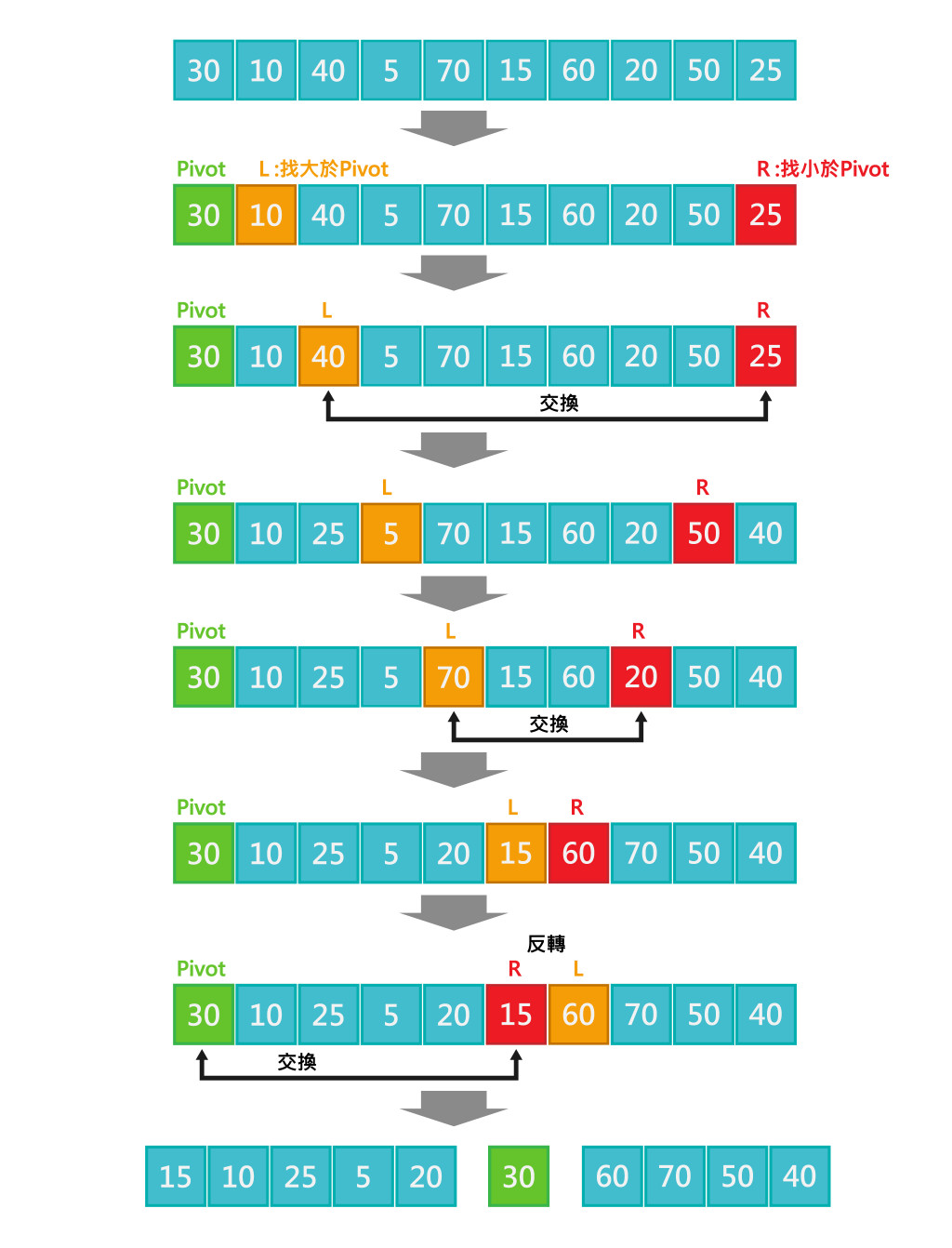
每回合简略图
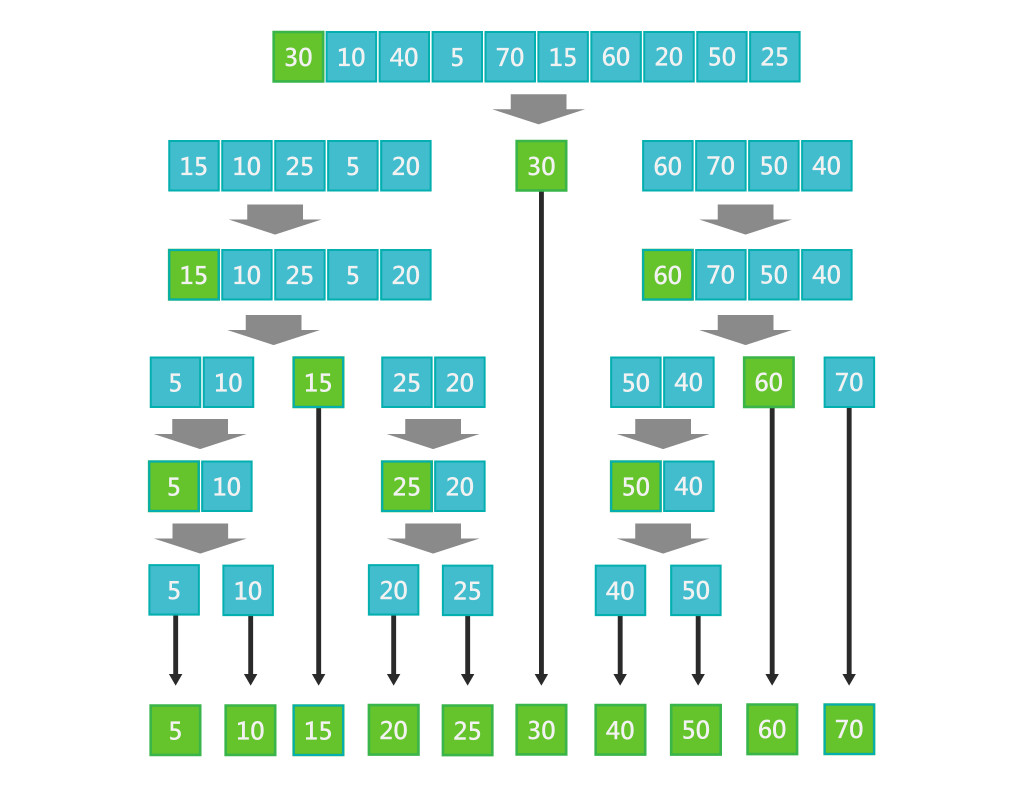
JavaScript
let data = [30,10,40,5,70,15,60,20,50,25];
function quickSort(arr, start, end) {
if (start < end) {
let pivotIndex = partition(arr, start, end);
quickSort(arr, start, pivotIndex-1);
quickSort(arr, pivotIndex + 1, end);
}
return arr;
}
function partition(arr, start, end) {
let pivot = arr[start]
let leftPointer = start+1
let rightPointer = end
let done = false
while (done===false) {
while (leftPointer <= rightPointer&&arr[leftPointer] <= pivot) {
leftPointer +=1
}
while (leftPointer <= rightPointer&&arr[rightPointer] >= pivot) {
rightPointer -=1
}
if (leftPointer > rightPointer) {
done = true
}else{
[arr[leftPointer],arr[rightPointer]]=[arr[rightPointer],arr[leftPointer]]
}
}
[arr[start],arr[rightPointer]]=[arr[rightPointer],arr[start]]
return rightPointer
}
console.log(quickSort(data, 0, data.length - 1))
//[5, 10, 15, 20, 25, 30, 40, 50, 60, 70]
Python
def QuickSort(arr, start, end):
if start < end:
pivotIndex = Partition(arr, start, end)
QuickSort(arr, start, pivotIndex-1)
QuickSort(arr, pivotIndex+1, end)
return arr
def Partition(arr, start, end):
pivot = arr[start]
leftPointer = start+1
rightPointer = end
done = False
while not done:
while leftPointer <= rightPointer and arr[leftPointer] <= pivot:
leftPointer += 1
while arr[rightPointer] >= pivot and rightPointer >=leftPointer:
rightPointer -= 1
if rightPointer < leftPointer:
done= True
else:
arr[leftPointer],arr[rightPointer] = arr[rightPointer],arr[leftPointer]
arr[start],arr[rightPointer] = arr[rightPointer],arr[start]
return rightPointer
data = [30,10,40,5,70,15,60,20,50,25]
print(QuickSort(data, 0 , len(data)-1))
#[5, 10, 15, 20, 25, 30, 40, 50, 60, 70]
<<: Day 22 - Shortest Distance to a Character
Day11 - 在 Next.js 中使用 CSR - feat. useSWR
为什麽我们需要 SWR ? 先前我们已经了解了 CSR、SSR 与 SSG 的优劣,SSR 与 SS...
例行监督表单撰写实务
上一篇内部稽核讲到 5. 监督作业:进行下列监督作业,以确定本制度之有效性、及时性及确实性: (1)...
收集和引出软件开发专业中利害关系人的安全需要(needs)和需求(requirements)
-软件开发生命周期 (SDLC) – 设计 在(需求)分析中引出、收集、分析、指定、记录、验证、确...
17. PHPer x Code Quality Tool
老板说程序码写得好就不会有 bug,你 bug 太多要扣你绩效。 为什麽前辈写的就没有 bug?我...